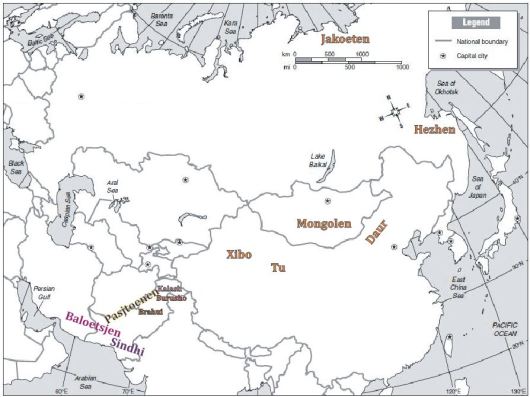(In the article of Joseph K. Pickrell en Jonathan K. Pritchard, “Inference of population splits and mixtures from genome-wide allele frequency data” their human family tree leads out of Africa.)
The following important split must have happened outside Africa. Around the estuary of the Indus a group probably continued following the coast and another one moved up the Indus to the North.
In this article an important new element appears for the first time. In Cambodia old genes were detected that had left Africa a long time before, and once out of Africa probably followed the southern coastal route along the Indian Ocean and thus arrived in Cambodia. These Cambodian genes that took the southern route were not the only ones. They were part of a larger stream of people, black people, whose descendants still live on the Andaman islands, Thailand, Birma, Indonesia, the Philippines, Southern China and of course all of Oceania.
Another branch split off to the North. The Indus is its most likely route. This study confirms the study of Stephen Oppenheimer [1] which I have used as the main base to study the spread of modern man from Africa, in my books on hunters and gatherers.[2]
The next progress of the Indus branch led to Central Asia. There the following split was that of people who moved to Eastern Siberia (and others to Europe). Their descendants would later make the crossing to America. Those that stayed in Southern Siberia would populate East Asia: Mongolia, China, Korea, Vietnam, Japan, but also Indochina and later further south to Indonesia and ultimately Polynesia where the met people that had followed the Southern route. The Siberian trek explains why both Europeans and East Asians have a pale skin, they have common origins in Central Asia. In their passage there having a black skin was a disadvantage [3]. Natural adaptation selected for a skin with a lighter color. On their journey from southern Siberia to the South they had contact with the descendants of the oldest Homo sapienses who lived there: black people who looked like black Africans today. There are still descendants of these that live in the Andaman Islands, the Philippines, Thailand, Malaysia and Papua New Guinea, Melanesia and Australia.[4]
The node in the Indus Valley provides many of the oldest genes in Asia. (See map) From the oldest DNA to the youngest: Burusho – Sindhi-Pashtuns –Kalash – Balochi – Brahui. This does not match an exact South-North axis but this can be explained that older DNA may disappear and younger DNA may continue to exist. The migration from Africa to the Indus valley, some 80,000 to 65,000 years ago, must have followed a South – North axis in the Indus Valley.
The oldest preserved DNA is from that from the Burusho. The Sindhi have a younger mutation, the Pashtuns a still younger and so on. It does not mean that the Baluchi travelled first to Northern Pakistan to relocate later in Southeast Iran and South-West Pakistan.
The Uyghurs but also the Hazara are people were fairly recently formed. Their DNA is a mixed one, it comes from different peoples.
Next part: admixture with archaic genes in the Indus valley.
[1]Stephen Oppenheimer, Out of Eden. The Peopling of the World, Constable, London, 200
[2] Marc Vermeersch. De geschiedenis van de mens. Deel I. Jagers en verzamelaars. – Boek 1, van Pan tot Homo sapiens. (405 pagina’s) – Boek 2, de maatschappij van jagers en verzamelaars. (472 pagina’s)
[3] (From Wikipedia) 1.From ~1.2 million years ago to less than 100,000 years ago, the ancestors of all people alive were dark-skinned Africans. (humans in the North may also have had a pale skin color)
2. As populations began to migrate, the evolutionary constraint keeping skin dark decreased proportionally to the distance North a population migrated, resulting in a range of skin tones within northern populations.
3. At some point, northern populations experienced positive selection for lighter skin due to the increased production of vitamin D from sunlight and the genes for darker skin disappeared from these populations.
[4] Mentioned in: Boek 2, de maatschappij van jagers en verzamelaars, p.12-135.

